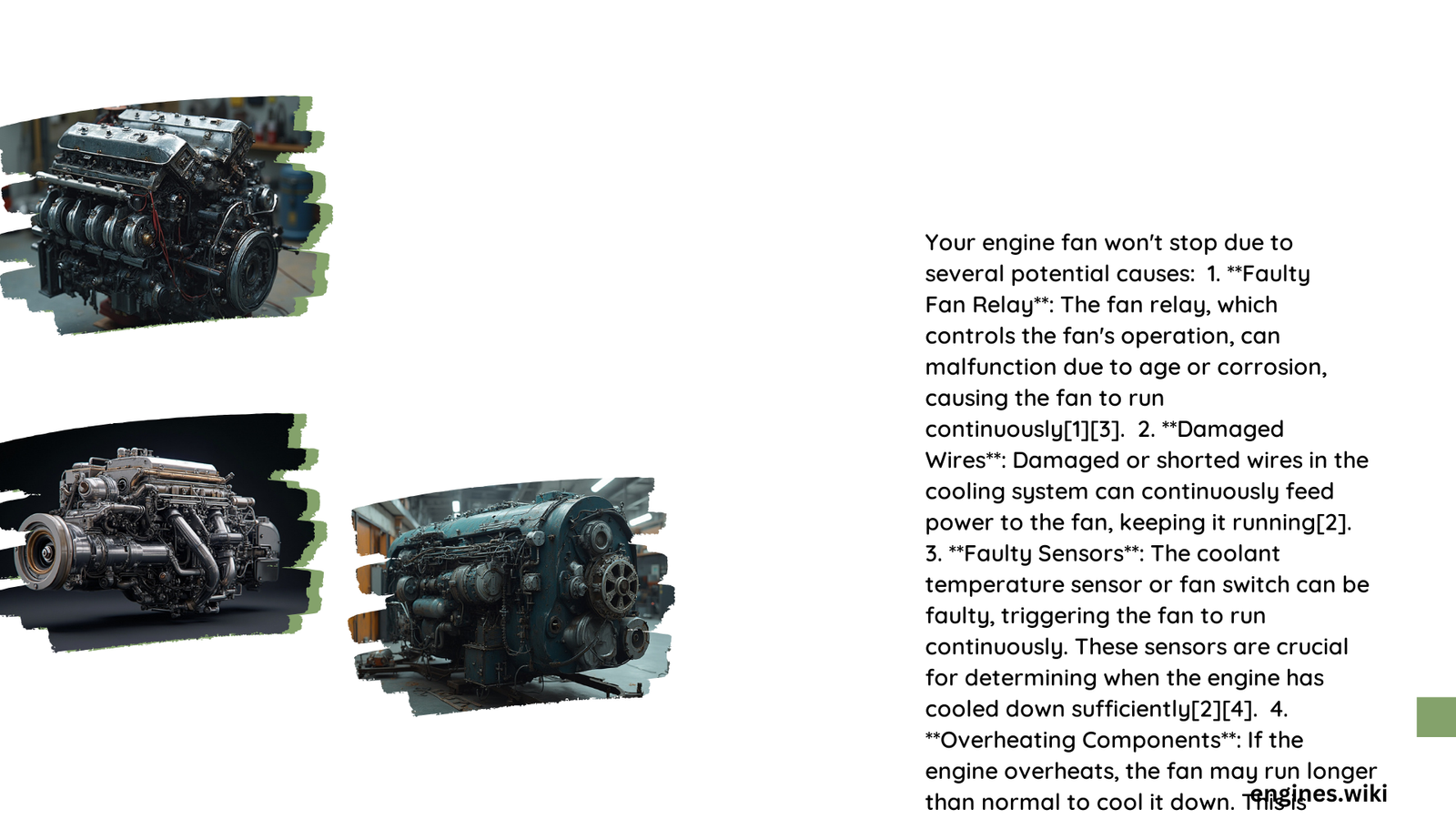An engine fan that won’t stop running can be a frustrating and potentially damaging issue for your vehicle. This problem often stems from malfunctioning components in the cooling system, such as a faulty relay, thermostat, temperature sensor, or fan switch. Understanding the causes and diagnostic steps can help you identify and resolve the issue, preventing potential engine damage and unnecessary fuel consumption.
Why Does My Engine Fan Keep Running?
The engine cooling fan is designed to regulate the temperature of your vehicle’s engine by drawing air through the radiator. Normally, it should only operate when the engine temperature reaches a certain threshold. However, several factors can cause the fan to run continuously:
- Stuck or faulty cooling fan relay
- Malfunctioning thermostat
- Faulty coolant temperature sensor
- Damaged fan switch or wiring
Let’s explore each of these potential causes and their diagnostic procedures in detail.
What Are the Symptoms of a Faulty Cooling Fan Relay?

A faulty cooling fan relay is often the culprit behind a continuously running engine fan. Here are the key symptoms and diagnostic steps:
Symptoms:
- Engine fan runs constantly, even after turning off the engine
- Fan operates continuously despite normal engine temperature
Diagnostic Steps:
- Check for a Stuck Relay:
- Use a Volt-Ohm-Milliammeter (VOM) to measure the relay voltage
-
If the reading is not 12V, the relay may be damaged and require replacement
-
Inspect Relay Pin Configuration:
- Locate the relay in the fuse box
- Measure resistance across the coil pins
-
Compare the reading to the vehicle’s specifications
-
Test Relay Function:
- Remove the relay and test it with a multimeter
- Check for continuity between appropriate pins when energized
How Does a Malfunctioning Thermostat Affect Engine Fan Operation?
A faulty thermostat can cause the engine fan to run continuously by preventing the coolant from reaching normal operating temperatures. Here’s what you need to know:
Symptoms:
- Coolant temperature doesn’t reach normal operating range (200-206°F)
- Engine fan runs constantly due to perceived overheating
Temperature Thresholds:
- Normal operating temperature: 200-206°F
- Faulty thermostat (stuck open) temperature: Below 176°F
Diagnostic Steps:
- Check Coolant Temperature:
- Use an OBDII code reader to monitor coolant temperature
-
If temperature remains below normal range, suspect a faulty thermostat
-
Thermostat Replacement:
- Replace the thermostat with a new one
- Monitor temperature readings to confirm resolution
What Are the Signs of a Failing Coolant Temperature Sensor?
A malfunctioning coolant temperature sensor can send incorrect signals to the Engine Control Module (ECM), causing the fan to run unnecessarily. Here’s how to identify and diagnose this issue:
Symptoms:
- Engine fan runs erratically or continuously
- ECM receives incorrect temperature readings
Expected Voltage Outputs:
- Sensor resistance decreases as temperature increases
- Voltage output to ECM increases with temperature
Diagnostic Steps:
- Sensor Unplugging Test:
- Unplug the coolant temperature sensor
-
If the fan stops running, replace the sensor
-
Voltage Output Measurement:
- Use a voltmeter to measure sensor output at different temperatures
- Compare readings with manufacturer specifications
| Temperature | Expected Voltage Range |
|---|---|
| 32°F (0°C) | 3.5 – 4.0 V |
| 68°F (20°C) | 2.5 – 3.0 V |
| 176°F (80°C) | 0.5 – 1.0 V |
How Can I Diagnose a Faulty Fan Switch?
A damaged fan switch or associated wiring can cause the engine fan to run continuously. Follow these diagnostic procedures to identify the issue:
Symptoms:
- Fan runs continuously or fails to turn off after engine cools
- Damage to negative wire or insulation failure
Diagnostic Steps:
- Continuity Check:
- Unplug the two poles of the wire connected to the fan switch
- Use a voltmeter to check for continuity
-
No power flow indicates a damaged wire
-
Switch Testing:
- Check current flow from relay to fan
- If power is present, suspect fan switch or wiring issue
-
Use a wire diagram to trace the problem
-
Visual Inspection:
- Examine wiring for signs of damage or corrosion
- Check for loose connections or frayed insulation
What Are the Consequences of a Continuously Running Engine Fan?
A fan that won’t stop running can lead to several issues:
- Increased Fuel Consumption: The fan draws power from the engine, reducing fuel efficiency.
- Battery Drain: If the fan runs after the engine is off, it can deplete the battery.
- Premature Component Wear: Continuous operation can lead to early failure of the fan motor or other cooling system components.
- Engine Overcooling: In some cases, a constantly running fan may cause the engine to operate below optimal temperature, reducing efficiency.
How Can I Prevent Engine Fan Issues?
To minimize the risk of engine fan problems:
- Regularly inspect coolant levels and quality
- Follow manufacturer-recommended maintenance schedules
- Address any unusual noises or vibrations promptly
- Keep the radiator and engine bay clean to ensure proper airflow
By understanding the causes and diagnostic procedures for a continuously running engine fan, you can effectively troubleshoot and resolve the issue, ensuring optimal engine performance and longevity.
